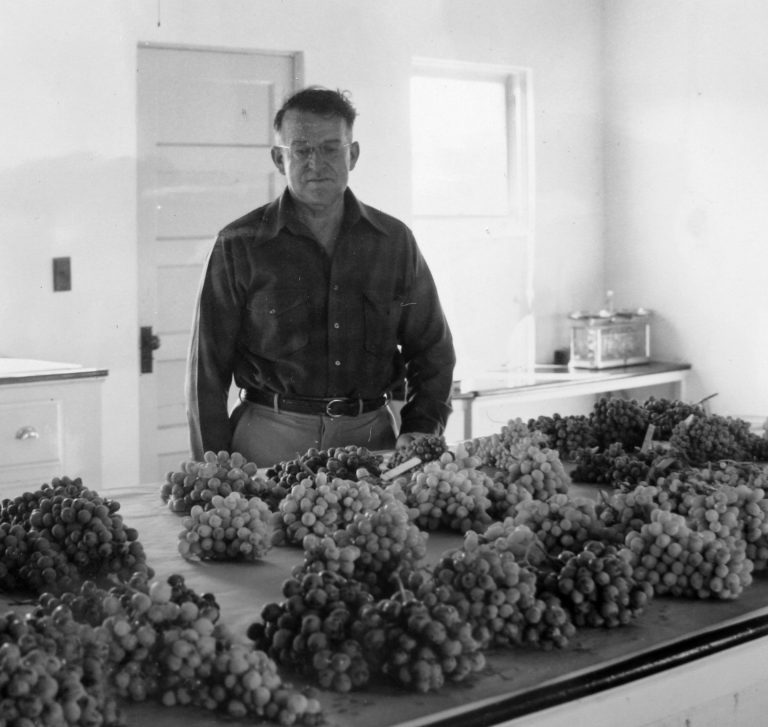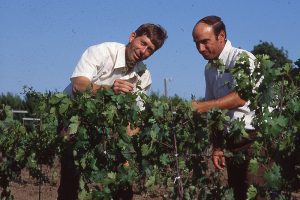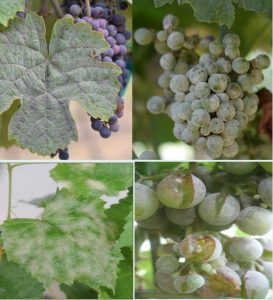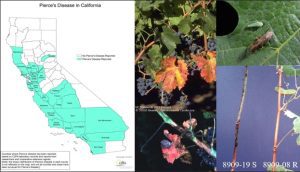
The history of grape research in the Central Valley dates back to 1916 with a modest program at the U.S Horticultural Field Station in Fresno, Calif. At that time, it was under the Bureau of Plant Industry program and was a USDA experimental vineyard, more famously known as Peach Avenue Station. The Station started with 20 acres of land that were donated by California grape growers. The first head of the Station was Elmer Snyder, who served until 1954. In earlier time, the main objectives of the station was production of table grapes and seedless grapes with Vitis vinifera background, new rootstocks with rootknot nematode resistance (Meloidogne spp.) and some work on special wine types. The first controlled cross was made in 1923, and by 1951 a total of 45,726 seedlings were grown from 399 crosses and 112 self- and open-pollinations of varieties and seedlings. It did not take very long for the table grape breeding program to release new varieties like Cardinal, Calmeria and Blackrose. The variety Cardinal resulted from a cross made in 1939 between Flame Tokay and Alphonse Lavallee. It was introduced in 1946 to the public, and by 1951 it was planted in San Joaquin, Coachella and Imperial valleys of California as well as parts of Arizona. Calmeria and Blackrose were introduced in 1950 and 1951, respectively. Dr. Snyder was an expert on table grapes and had intimate knowledge of the history of vineyards in the San Joaquin Valley and could tell which varieties were grown in vineyards simply by driving down the road. Among his peers, he was nicknamed ‘Elmer the Great Emasculator.’

Program Focus Shifts
Dr. Jonnie Weinberger joined the program in 1954 and more emphasis was put on breeding stone fruits.
Dr. Horace Loomis was more focused on grape breeding. The research of this duo was very productive over the years in terms of developing new varieties of both grapes and tree fruit with extended season, extended marketing time with better cooling and storage methods, and improved packaging. Dr. Weinberger retired in 1975 with a legacy of releasing over 35 peach, nectarine, plum, apricot, table grape and raisin grape varieties. Two of his selections, Flame seedless (table grape) and Fiesta (raisin grape), are still grown in many parts of the Central Valley. Dr. David Ramming joined the program in 1975 and shifted the focus of the program back to grape breeding. During his time, progress was made to streamline the laboratory technique of embryo rescue that allowed using two seedless grape plants as parents to develop new seedless offspring. This technique has significantly shortened the time required for development of new table grape and raisin grape cultivars.

The raisin variety DOVine (dry on vine) was the first release that resulted from the hybridization of two seedless grapes using embryo rescue techniques. DOVine resulted from a cross of 79-101 and Fresno Seedless made in 1983. 79-101 is a blue seedless grape of unknown parentage; Fresno Seedless is a sibling of Flame Seedless and resulted from the cross of Cardinal and Thompson Seedless; Red Malaga and Tifafihi Ahmer; and Muscat of Alexandria and Thompson Seedless. Dr. Ramming was instrumental in developing over 40 varieties of table grapes, raisin grapes, peaches, apricots and other stone fruits; 15 of his table grape varieties represent more than half of table grape production in California. The raisin grape industry was revolutionized by release of DOVine and Selma Pete that could be dried on the vine by cane cutting, and mechanical harvesting could be implied. The Sunpreme, a newly released variety (2015) by the breeding program, offers further improvement to the raisin industry. The fruit of Sunpreme dry naturally on the vine and becomes raisin; no cane cutting is required.
The program at Avenue Peach Station also benefitted from the contributions by Dr. David Cain on grape rootstock breeding between 1979 and 1981.
In 1981, the California Table Grape Commission began a decades-long partnership with the breeding program that continues today.

Breeding Against Disease
In late 80s, land was purchased to develop the San Joaquin Valley Agricultural Sciences Center at Parlier. By fall 2000, the main building was complete and in 2001, some operations of the fruit breeding program moved to the current location in Parlier, Calif. However, field location of the breeding program stayed at California State University, Fresno till 2004. Dr. Ramming continued his breeding work with a focus on disease resistance for grape powdery mildew and Pierce’s disease.
Grape powdery mildew is a fungal disease that attacks all growing plant parts, and if not controlled can cause complete crop loss. The USDA grape breeding program identified disease resistance in wild relatives of grapes and used traditional crosses to bring resistance in the new varieties. DNA-based genetic markers are also used to identify and select seedlings that will retain desired traits of resistance. Dr. Craig Ledbetter led grape breeding efforts in addition to his successful Prunus breeding program at the Center upon Dr. Ramming’s retirement in 2013. Dr. Rachel Naegele contributed to the grape breeding program between 2015 and 2021. Until his retirement in 2022, Dr. Ledbetter’s leadership enabled multiple grape showings per season in partnership with the California Table Grape Commission. His ingenuity allowed the program to persevere during the COVID-19 pandemic. Dr. Summaira Riaz joined the program from UC Davis in 2022 as a research geneticist in the Crop Diseases, Pests and Genetics Research Unit (CDPGRU) at the Center to continue the tradition of impactful table and raisin grape breeding.

Following on a century of achievements by giants in grape breeding with the program, Dr. Riaz is poised to benefit from previous collective efforts to develop and introduce new cultivars of seedless table grape and raisin varieties that are high-yielding with improved fruit quality and consumer appeal and require less cultural practices. It is also essential to develop varieties that are better adapted to climate change. Advanced molecular approaches will be applied to research on disease resistance. Dr. Riaz’s experience is an asset that will benefit the program into the next century using innovative research tools like access to resistant germplasm, knowledge of genetic resources and hands-on experience with modern genomic tools to put the breeding program on the fast track. The conditions are ripe for a bright future of grape breeding at the Center given the collaborative nature of research by USDA-ARS and its partnership with stakeholders representing the California table and raisin grape industries that continue to deliver grape varieties with traits popular among consumers.








